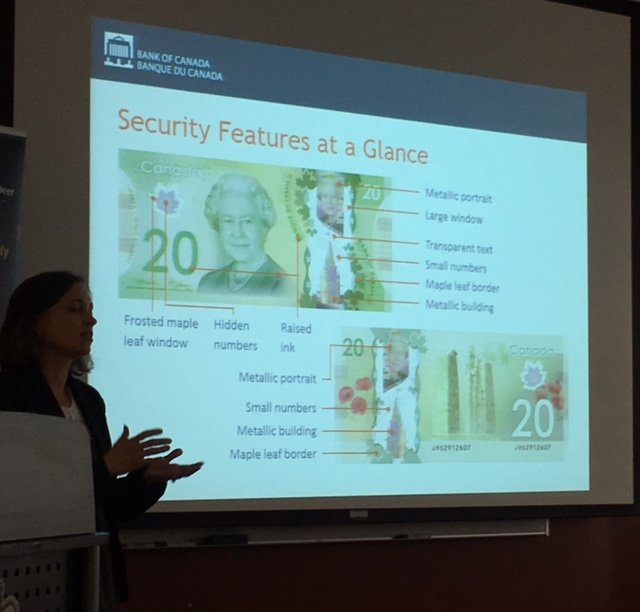Red Deer is being called a ‘hub’ of activity for counterfeit currency by officials who gave a presentation in the City on Wednesday.
About 25 people attended a public presentation to assist them in learning to recognize counterfeit currency. The presentation was held in support of Crime Prevention Week at the downtown RCMP detachment.
“There is a difference of volume in occurrences in Red Deer versus other areas – that is just Red Deer specific. If I was to look at Lacombe, Sylvan Lake, Blackfalds, Ponoka – very neighbouring communities, they are also being hit. It’s on that Hwy. 2 corridor,” said Cpl. Joseph Stubbs, counterfeit lead officer from the Alberta RCMP, adding counterfeit money is primarily done by those involved in organized crime. “The areas being hit are on the main corridor. There is very much a correlation between transient people and occurrences.”
Michelle Marselle, a counterfeit expert from the Bank of Canada along with Stubbs presented examples of counterfeit techniques, education on how to recognize counterfeit currency and the opportunity to see and handle examples of counterfeit currency.
“The purpose was to make sure the business people in Red Deer know what the security features are on Canadian currency,” said Stubbs. “We have some instances where in Red Deer and throughout Canada and Alberta, counterfeit currency is being passed and what we are finding is it’s because of lack of knowledge of what to check for. It’s very much an education piece.”
He added there are three simple steps to help ensure that the currency Red Deerians have is not counterfeit.
“We talked about three key things to know, which are feel, look and flip,” said Stubbs, adding $20 bills are what is seen as the highest currency being counterfeited. “We are encouraging everybody that when they handle cash in whatever sort of environment, that you use those three steps to look at your currency and say I can feel it – it feels like Polymer, it doesn’t feel like anything is pasted into it, it doesn’t feel like anything has been taped into it. It has the proper raised print that it should. When I am looking at it, it does the things that it is supposed to do as far as the holograms and seeing your hand through the open windows.
“And then flipping it – the back of the hologram should do the exact same thing as the front.”
Since the Bank of Canada began distributing Canadian currency in Polymer, as opposed to distributing currency printed on paper, Stubbs said the number of counterfeit bills has been reduced.
“The volume of counterfeit currency has drastically dropped with Polymer bills,” he added. “Right now in Canada, it’s less than nine parts per million counterfeit currency in circulation.”
Stubbs said however, one current trend in currency counterfeit is known as, “Frankenstein money”.
“It’s where you’ve taken something real and added it to something not real. It’s almost an Alberta-phenomenon. When I talk to colleagues across Canada, they are all experiencing different types of counterfeiting,” he said. “They are taking an legitimate holographic strip and cutting it out of smaller denomination bills and then taping it into paper counterfeits of a larger denomination counterfeit.”
For more information on Canadian counterfeit currency, bankofcanada.ca and the Canadian RCMP web site and search ‘counterfeit currency’.
For information on U.S. counterfeit currency, visit newmoney.gov.



